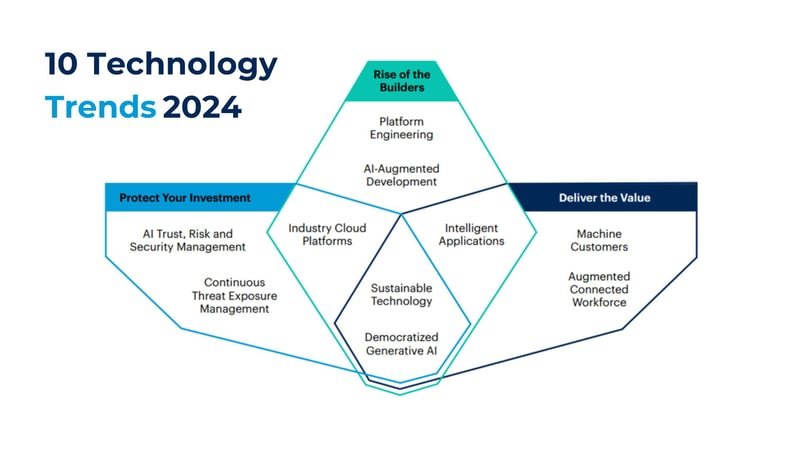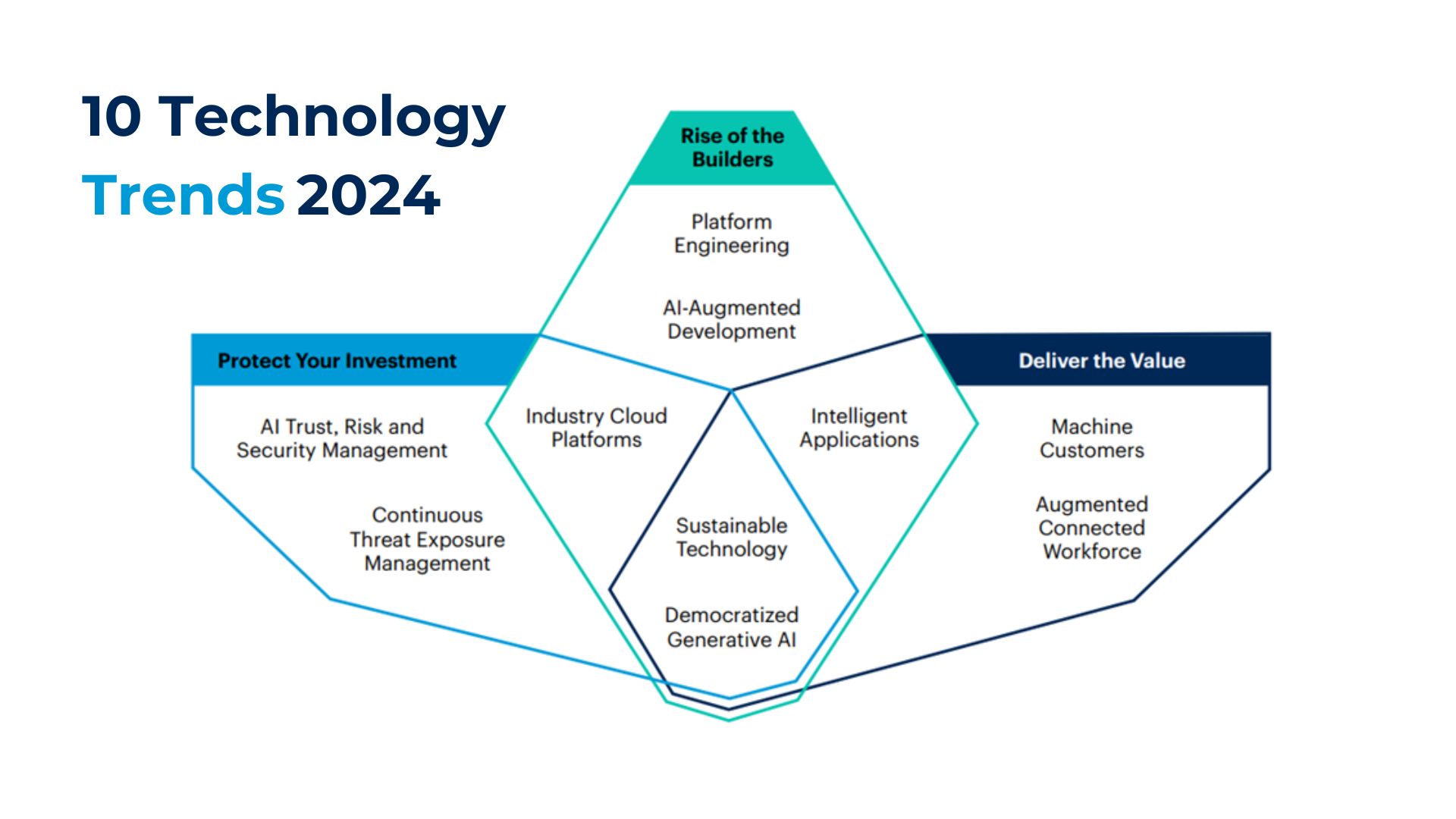Gartner has just published a report with the 10 technology trends that will shape the business landscape in 2024. Discover the 10 trends here!
Each year, Gartner identifies the technology trends that will have a strategic impact in the coming year. The 10 trends listed in this post are expected to have a significant influence on the business world in 2024, demanding a response from executives responsible for digital and/or IT strategy over the next 0-36 months. Don't miss the 10 technology trends of 2024!

In today's era of fast evolving artificial intelligence (AI), technology innovation is critical to create business value. Likewise, for business leaders, identifying the technologies that will have the most impact in the near future is key to making better investment decisions and not falling behind competitors.
Each year, Gartner publishes a report with the 10 technology trends that will have the greatest impact on the business world in the coming year. Gartner expects that the 10 trends selected for 2024 will have an impact on at least 20% of organisations. Technology leaders, CEOs and IT managers need to understand and assess how these technologies present opportunities and risks to the strategic direction of their business.
If implemented successfully, these technologies offer advantages such as:
- Reliability to use AI safely and securely
- Sustainable activities within the ecosystem in which a company operates
- Dedicated technologies for specific tasks, industries and functions
- Increased speed and productivity with minimal additional investment or effort
- Increased value for internal and external stakeholders
In which technologies will companies invest in 2024?
Gartner predicts that the following 10 trends will influence business and technology decisions over the next 36 months. Whether and when to adopt these technologies depends largely on an organisation's specific business objectives and current situation. It is crucial that the implementation of these technologies is aligned with business objectives, ensuring that they deliver real value.
CEOs, CTOs and IT managers should therefore take the following precautions to protect their investment decisions:
1. Calculate and evaluate the return on investment of strategic technological decisions, both past and future, so that the generation of value is sustainable over time.
2. Empower employees and developers to create strategic solutions with the right technology. When making investment decisions, it is best to select technologies that will not only benefit technical specialists, but will generate value across the board at all levels of the company.
3. Enable value delivery through a cycle of improvement and acceleration of value optimisation. It is important to continuously make adjustments to meet new demands, both internally and from external customers.
Top 10 Trending Technologies for 2024
1. AI Trust, Risk and Security Management (AI TRiSM)
Artificial intelligence is probably the most dynamic technology at the moment. Therefore, implementing governance measures that analyse the risks of AI use, promote trust in AI and ensure the security of internal processes and data is one of the most important tasks for 2024.
According to Gartner, artificial intelligence management technologies (AI TRiSM) support the governance, reliability, fairness, robustness, transparency and data protection of AI models.
-
Prediction: By 2026, businesses that apply TRiSM controls to AI applications will increase the accuracy of their decision-making, eliminating 80% of erroneous and misleading information.
AI TRiSM: Why trending?
According to Gartner, organisations that actively use AI trIsm, move more AI projects into production, achieve more business value and experience greater model accuracy and consistency than those that do not. These technologies improve decision bias control and increase fairness in AI-based applications.
AI TRiSM: Where to start?
It is recommended to establish a dedicated working group or unit to manage AI management and control efforts. It is important to work at all levels of the organisation to effectively manage the best toolsets as part of a comprehensive AI TRiSM programme.
Furthermore, it is important to define AI usage policies and establish a system to methodically record and approve access to AI models and certify their actual use.
2. Continuous Threat Exposure Management (CTEM)
A continuous threat exposure management is a pragmatic and systemic approach to continuously adjust cyber security optimisation priorities.
-
Prediction: By 2026, organisations that prioritise their security investments based on a continuous threat exposure management (CTEM) programme will reduce security breaches by more than 65%.
Continuous Threat Exposure Management: Why trending?
An increased focus on security aligns exposure assessment cycles with specific business projects or critical threat vectors.
Continuous Threat Exposure Management: Where to start?
It is important to integrate security technologies consistently and aligned with awareness and risk management programmes to provide a business-driven approach and prioritisation based on the business value of exposure mitigation.
Adopting cyber security validation technologies can enhance existing prioritisation workflows and improve cyber security preparedness.
3. Sustainable technology
Sustainable technology is a framework of digital solutions used to enable environmental, social and governance (ESG) outcomes that support long-term ecological balance and human rights.
- Prediction: By 2027, 25% of CIOs will have remuneration linked to their impact on sustainable technology.
Sustainable technology: Why trending?
Sustainable technology is a range of different aspects needed to improve overall sustainability and performance:
- Environmental technologies prevent, mitigate and adapt to risks in the natural world.
- Social technologies improve human rights, welfare and prosperity outcomes.
- Governance technologies strengthen business conduct, oversight and capacity building.
Sustainable technology: Where to start?
It is advisable to select technologies that help drive sustainability in the sector and that are considered a priority for the company and key stakeholders.
Technologies that drive sustainability can include cloud services, AI solutions and others. It is important to create and involve the ethics committee in the development of a structured decision-making roadmap and to find an appropriate balance between the technologies already in place in the company and the new technologies it is considering acquiring.
4. Platform Engineering
Platform Engineering is the discipline of building and operating internal self-service platforms. Each platform is a layer, created and maintained by a dedicated product team, designed to support user needs by interfacing with tools and processes.
- Prediction: By 2026, 80% of software engineering organisations will establish platform teams as internal providers of reusable services, components and tools for application delivery.
Platform Engineering: Why trending?
This practice optimises the developer experience and accelerates the delivery of business value, improving developer productivity.
It also increases developers' ability to run, manage and develop their applications independently, while ensuring reliability and security.
Platform Engineering: Where to start?
It is best to start by creating internal platforms with reusable, composable and configurable components, knowledge and services, treating the platform as a product.
It is also wise to work collaboratively with the end users of these platforms to identify and prioritise the technical capabilities, tools and processes that are most useful to them, and then build the platform around all considerations.
5. AI-powered development
AI-powered development involves using AI technologies, such as generative artificial intelligence and machine learning (ML), to help software engineers build, test and deliver applications. These are AI technologies that make programming faster and easier.
- Prediction: By 2028, 75% of enterprise software engineers will be using AI coding assistants, up from less than 10% in early 2023.
AI-powered development: Why trending?
AI-enhanced development tools integrate with an engineer's development environment to produce application code, translate legacy code into modern languages, enable design-to-code transformation and improve application testing capabilities.
-
AI-assisted software engineering improves developer productivity and enables development teams to cope with the growing demand for software to run the business.
-
AI-powered development tools allow software engineers to spend less time writing code, enabling greater focus on higher-level activities such as designing and composing engaging business applications.
AI-powered development: Where to start?
It is desirable to establish a team of senior software engineers who can evaluate AI code generation tools to determine how best to deploy and use these tools. It may also be worthwhile to evaluate and deploy test AI tools to test their effectiveness.
6. Industry cloud platforms
Industry Cloud Platforms (ICPs) are cloud services that are tailored to a specific business sector and allow companies to tailor them to their specific needs.
Prediction: By 2027, more than 50% of enterprises will use industry cloud platforms to accelerate their business initiatives, compared to less than 15% in 2023.
Industry cloud platforms: Why trending?
Industry cloud platforms help organisations address business outcomes relevant to their industry by combining the underlying SaaS, PaaS and IaaS services into a complete product offering with composable capabilities.
Industry cloud platforms: Where to start?
Gartner recommends assessing industry cloud platforms (ICPs) to complement the existing application portfolio, introducing new capabilities that add value, rather than replacing existing capabilities. They also recommend involving enterprise technology experts and merger teams in this process so that they understand and support the ICP tooling process across the enterprise.
7. Intelligent Applications
Intelligent applications are those that include artificial intelligence capabilities and integrate connected data from transactions and external sources to offer a better service.
- Prediction: By 2026, 30% of new applications will use AI to power personalised and adaptive user interfaces, up from 5% today.
Intelligent Applications: Why trending?
Generative AI can make applications truly smarter, transforming the experience for customers, users, product owners, architects and developers.
-
By infusing data from transactions and external sources, intelligent applications bring information inside the applications that users already use, so they won't need separate business intelligence tools to assess and understand the state of the business.
-
AI can add predictions or recommendations, rather than more procedural functions, allowing applications to adapt to the user, improving outcomes and advancing data-driven decision making.
Intelligent Applications: Where to start?
It makes sense to start by establishing a centre of excellence or a team with similar functions to capture, explain, catalogue, map and monitor the breadth and depth of intelligence as a capability within existing internal applications.
On the other hand, assess how intelligent applications transform the scope, purpose and functionality of enterprise applications as the range and scope of intelligent applications expands over the medium to long term.o.
8. Generative AI
Generative artificial intelligence is a type of artificial intelligence that has the ability to create new content (images, voice, text, etc.). The widespread availability of Generative AI tools such as ChatGPT contribute to the democratisation of access to information and advanced AI capabilities. This has made Generative AI one of the most disruptive trends of this decade.
- Prediction: By 2026, more than 80% of enterprises will have used generative AI APIs, models and/or deployed generative AI-enabled applications in production environments, a significant increase from 5% today.
Generative AI: Where to start?
Democratising access to generative AI across the organisation offers the potential to automate a wide range of tasks, boost productivity, reduce costs and provide new opportunities for growth.
- Business users gain access to knowledge and technical skills they did not previously have, significantly increasing their productivity.
- The confluence of cloud and open source will in the future democratise generative AI beyond the realm of the big tech giants.
- Unrestricted access to knowledge and skills must be backed by a strong focus on data governance and responsible AI practices.
In short, Generative and democratised AI (with pervasive access) has the capacity to transform the way businesses work in the very near future. Pervasive AI fosters the democratisation of information and skills across a broad set of business roles and functions, as users can access vast sources of information, both internal and external, through natural language conversational interfaces.
Democratised Generative AI: Where to start?
It is important to implement Generative AI with caution, studying its use cases within the enterprise, considering both its technical feasibility and the tangible business value that its widespread use would bring.
Organisations are starting from a change management approach that prioritises employee training and wellbeing, equipping them with the skills to use Generative AI tools with confidence and trust, while assuring them that these tools will help them automate routine tasks.
9. Augmented and connected talent
Augmented and connected talent is positioned as a strategy to optimise the value delivered by the human workforce by establishing a connective tissue that optimises the use of smart technology, workforce analytics and augmented skills to accelerate and scale talent production.
- Prediction: By 2027, 25% of CIOs will use augmented connected workforce initiatives to reduce skills acquisition time by 50% for key positions.
Augmented and connected talent: Why trending?
This strategy accelerates the new (digital) skills needed for work in all types of employment. Digital tools reduce skills acquisition time for new hires.
An augmented and connected talent strategy increases worker productivity through advances in automation and AI. However, these innovations require workers to be increasingly able to manage complex issues.
Augmented and connected talent: Where to start?
Companies should prioritise the skills acquisition of their workforce. Gartner also recommends designing better employee experiences through the use of smart technology.
10. Machine Customers
Machine customers are non-human economic actors who purchase goods and services in exchange for payment.
- Prediction: By 2028, machine customers will render 20% of human-readable digital storefronts obsolete.
Machine customers: Why trending?
For the first time in human history, companies will be able to create their own customers.
According to Gartner, by 2028, there will be 15 billion connected products with the potential to behave like customers, with billions more to follow in the coming years. These new "machine customers" will impact trillions of dollars in purchases by 2030 and will become more important than the advent of digital commerce.
Machine customers: Where to start?
The US consultancy, Gartner, recommends the creation of a machine customer research team with high-level strategic representatives to explore the business opportunities of these new digital players.
It is also essential to start assessing the design of the data sources and API platform needed to serve automated customers who should not or do not want to use their human-readable digital storefront.
Next steps: Technology decisions to make in the next 3 years
In conclusion, the 2024 business landscape looks like an exciting field of opportunities where CEOs' investment decisions will be intrinsically linked to the identification and adoption of trending technologies.
The ability to anticipate the significant impact of these innovations on the achievement of corporate objectives and the agility to implement them will be key pillars of the decision-making process. The strategic vision of business leaders will be challenged and enriched by considering fictitious scenarios that illustrate the effective application of these technologies in the pursuit of specific business outcomes.
In this dynamic scenario, the synergy between strategic vision and technology adoption stands as the key to success, setting the pace for an era where innovation and decision-making converge to drive business growth.



